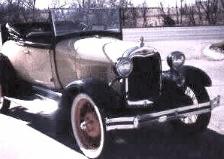
f golf balls, transatlantic cables, root canals and Model A Fords I sing. When it comes to golf stuff, I must say I'm like Barry Fitzgerald in Going My Way , I've never had a caddy in my hand. But I once called home from London, England, and said, "Send more money;" I've owned a root canal or two in my day; and I confess to having had a deep, almost amorous attachment to a Model A Ford much like the one shown here, except not in such good condition.

In the beginning, when God was creating things right and left, He somehow overlooked golf balls, which have suffered ever after from being merely man-made. The first were made of wadded up duck feathers with a leather cover. The cover was stitched almost together, wet duck feathers were crammed in until the sphere would hold not another one, then a few more were jammed in and the stitching was completed.
When the feathers dried, the ball was as hard as, well, a golf ball. As you can imagine, this was a tough, tedious undertaking requiring strong stuffers and jammers with stiff upper lips because it made your fingers sore as the dickens. As a result, golf balls were quite expensive and affordable by only the very well-to-do.
Meanwhile, over in Malaysia there were standing several trees of the sapodilla persuasion whose sap, though similar to rubber, turned out to be harder when cured. Some of it found its way back to St Andrews in Scotland as packing material in shipping crates, and there some idler rolling it about in his hands inadvertently created a new golf ball.
The stuff was plentiful, easily molded by even the village idiot or local golf pro, whichever arrived first, and the new balls could be whammed further by far than those silly feather things. The price of golf balls dropped to the point the masses could afford them, and almost overnight golf became an international sport. There was one drawback. If struck with great determination by a strong player on a very cold day, the new balls were prone to shatter into smithereens, a bad thing to happen in the course of a casual Sunday morning foursome, a disaster in a tournament. A rule had to be made to cover it. It allowed a player in such a pickle to drop another ball. Eventually, balls made with elastic windings which were less likely to fall to pieces were developed as replacements. I don't know whether the rule was ever dropped or not.
Other noble uses were found for the sapodilla sap. One was a waterproof insulating cable cover enabling the establishment of the transatlantic telephone service, but eventually plastics came along and did the job better.
Today, the product is still used by dentists who have been neglecting their continuing education requirements and still persist in poking it into root canals, but even that practice is fading away.
After having served man well, it appears the stuff is headed for the dusty dumpster of industrial has-beens. Yet, because of its name, which we took from the Malaysians along with the product, it will never be forgotten, at least not by me. Its name, you see, recreates perfectly that beautiful, soul satisfying sound of my long lost beloved Model A Ford at idle, Gutta-percha, gutta-percha, gutta-percha .